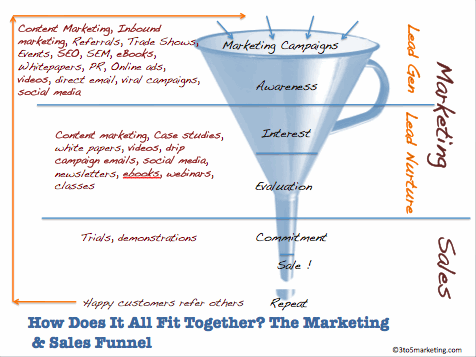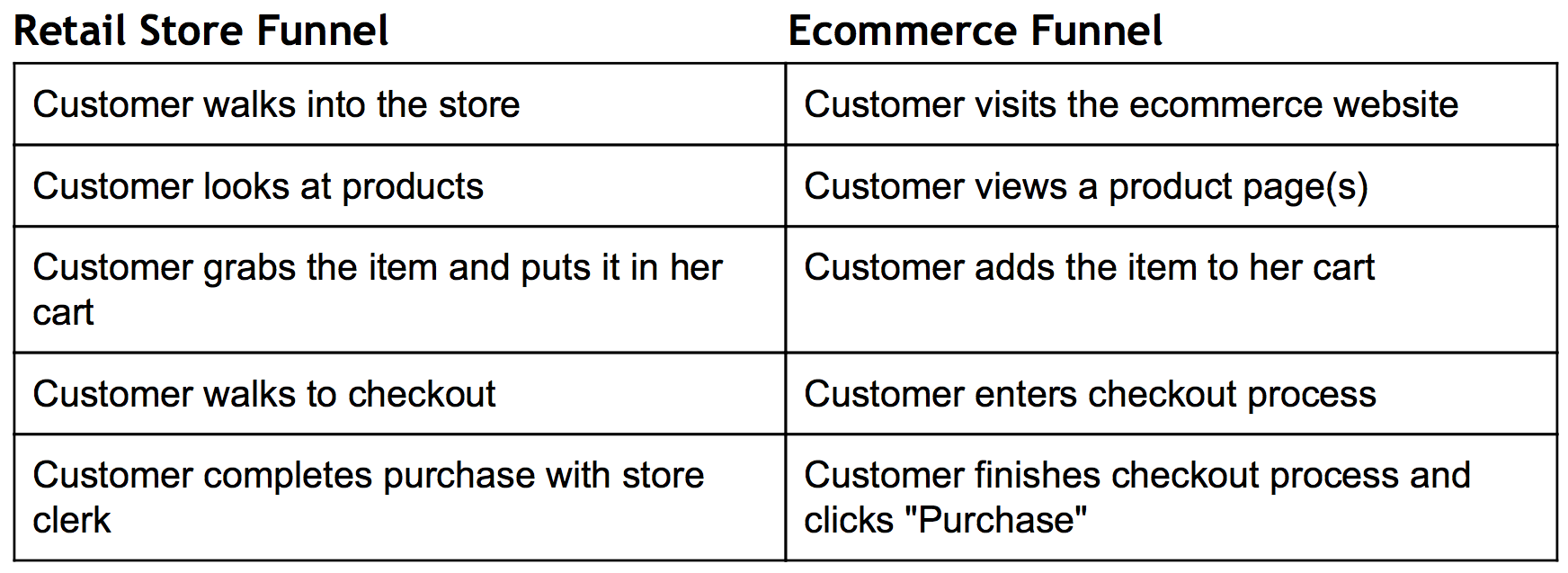If you’ve spent any time learning about marketing analytics, you’ve probably come across the term “funnels.” If you’re curious about what they are and how they can help, this post is for you.
What Are Funnels?
You undoubtedly want visitors on your website to take certain actions.
Maybe you want them to make a purchase, sign up, or fill out a form. When someone does something you want them to do, it’s known as a conversion. The visitor converts from browsing to taking the action you want them to take.
A funnel is the set of steps a visitor needs to go through before they can reach the conversion.
Think about the Amazon purchase funnel. There are a few steps a visitor has to go through before they can purchase a product. Here’s how it looks:
- They have to visit Amazon.com
- They have to view a product
- They have to add a product to the cart
- They have to purchase
There are additional steps/actions that can be taken in between each of these steps, but they do not matter in the purchase funnel. For example, a visitor may view Amazon’s About page, Contact page, and Careers page, but we don’t need to count these in the funnel because they aren’t necessary steps.
Why is the set of steps to conversion called a “funnel”? Because at the beginning of the process, there are a lot of people who take the first step. Then, as the people continue along and take the next steps, some of them drop out, and the size of the crowd thins or narrows. (And even further along in the process, your sales team gets involved to help close the deal.)
The top of the funnel is where everyone goes in (visiting your site). Only the most interested buyers will move further down your funnel.
So when you hear people say “widen the funnel,” you now know what they are referring to. They want to cast a larger net by advertising to new audiences, increasing their brand awareness, adding inbound marketing, etc. in order to drive more people to their site, thus widening their funnel. The more people there are in a funnel, the wider it is.
You aren’t limited to using your funnel strictly for signing up and/or purchasing. You can put funnels all over your website to see how visitors move through a specific website flow.
You may want to track newsletter signup (Viewing newsletter signup form > Submitting form > Confirming email) or a simple page conversion (Viewing a signup page > Submitting signup).
Figure out what your goals are and what you want visitors to do on your site, and you can create a funnel for it.
Once you have the data, you’ll be able to see where roadblocks are and optimize your funnel. Let’s dig a little deeper into that.
Why Funnels Are Beneficial
With a funnel report, you can see where you are losing customers.
Let’s take your average SaaS business as an example. Here’s how a funnel may look for them:
- Visited site
- Signed up for a trial
- Used product
- Upgraded to paying
Do people have to use the product before paying? They don’t, but it’s a good idea to track it so you can see if it’s a roadblock for them.
A Funnel in Real Life
Funnels occur everyday with consumers. Let’s look at the funnel process for a retail store and see the corresponding steps in an e-commerce store. We’ll be tracking a purchase funnel.
The Ecommerce store has the fortune of being able to see a funnel. It would look something like this:
Okay, so now we have an understanding of what a funnel is and why it helps. Let’s take a look at a product that offers funnels – Google Analytics.
How Google Analytics Funnels Work
Google Analytics offers funnels, and we’ve written extensively about it in the past. There are a couple things you’ll need to know when creating funnels in Google Analytics:
- It’s a pretty basic funnel. If you don’t want to dive deep into the data and optimize, you can go with this.
- You cannot go back and retroactively view data. Once you create your funnel, you’ll only be able to the funnel going forward as the data comes in.
Click here to learn how to set up a conversion funnel in Google Analytics.
Recap
We’ve gone through a fair amount, here’s a recap:
- When someone on your website does something you want them to do (i.e., sign up, make a purchase, fill out a form, etc.), it is known as a conversion.
- A funnel is used to track the steps that lead up to that conversion. For example, e-commerce companies want people to purchase products on their website. Their funnel may have these steps – visited site > viewed product > placed product in cart > purchased.
- Using a funnel report you can see where people are dropping off in the path to conversion.
- Google Analytics provide funnels as part of the free Google Analytics software.
About the Author: Zach Bulygo (Twitter) likes marketing, finance, and learning about different businesses.



Comments (39)